In-Depth with the Windows 8 Consumer Preview
by Andrew Cunningham, Ryan Smith, Kristian Vättö & Jarred Walton on March 9, 2012 10:30 AM EST- Posted in
- Microsoft
- Operating Systems
- Windows
- Windows 8
Technically, everything in the Windows 8 Consumer Preview is in a non-final preview, but some things obviously need a bit more work than the others—one of these areas is the core set of Metro apps included with the Consumer Preview, all of which carry a prominent APP PREVIEW label. For this reason, we're just taking a limited look at just a few of Microsoft's core Metro apps for now—we'll do a deeper dive when they're finished, but at least for now it doesn't make a lot of sense to do a head-to-head comparison with their counterparts in iOS and Android. That said, let's continue:
Metro’s Mail uses a design that’s very common in email clients: You have accounts/folders in the left, emails in the middle and the selected email in the right-hand-side. The overall design is extremely bare, something you’re not used to in a desktop email client. There aren’t any visible buttons when in accounts/folders view but when you select a certain account or folder, you get buttons for new email, respond and delete. The respond button holds reply, reply all and forward functions inside it. Right-clicking fires up the so-called menu, which allows switching between accounts and folders view, as well as options to move or mark the email or sync your accounts.
The actual text editor offers a bit more power than the rest of the mail client. Once again, the tools are a right-click away but fortunately, the text editor isn’t as limited as other parts of the app. The basic text editing features are present along with some additional email tools. One should also note that the default signature is “Sent from my Windows 8 PC”, which is more or less a direct copy of Apple’s “Sent from my iPhone/iPad” signatures.
What about supported services and protocols? First and foremost, Metro’s Mail client only supports Hotmail, Gmail and Exchange accounts. Yes, you read it right, there is no support for 3rd party POP or IMAP services as of this writing. This is a huge drawback if you use any other services. For example, our AnandTech mail server is IMAP, which means I can’t use my work email with Metro’s Mail client. Of course, it’s possible to auto-forward emails from other services to Hotmail/Gmail, but that’s not a very convenient solution—hopefully this will change in the final version of the app.
Overall, Metro’s Mail client is fairly awkward for desktop use. It makes sense on a tablet with limited screen estate, but even a free email client like Windows Live Mail is way more powerful and usable in desktop environment. It doesn’t seem logical to be constantly right-clicking in order to access the menu when regular desktop email clients have the menu visible at all times. Even simple commands like reply and syncing are buried under a second click, which is just illogical.
Calendar
Metro’s Calendar is similar to Mail: It’s a very scarce app with not much extra. In Mail, this was a bigger issue but a calendar app doesn’t need to be filled with features to do its job.
The design is very basic. The background is grey and event tiles are in bright colors. Weekends show up in darker grey in day and week views, distinguishing them from weekdays.
Navigation is once again hidden behind a right-click, which brings up options for alternating between day, week and month views, as well as option to navigate to today or add a new event. Adding an event can also be done by clicking a tile where you want to schedule the event to. Navigating between days/weeks/months is done by bringing your mouse close to the upper corners and clicking an arrow.
Adding an event has the common tools which are used by many other services. You can add a location, message, reminder and so on. There is an option to select the calendar where you want the event to be added, which is useful if you use different calendars/services for home and work purposes for example.
Service support is the same as Mail’s: Google, Microsoft (via Windows Live), and Exchange. I quickly tried Google and Microsoft and they synced fine. There is a slight delay in Metro’s Calendar so it takes a while before an event shows up. Different colors in the calendar stand for different services – in this case Google is in blue and Microsoft is in green.
Again, it feels odd to be constantly right-clicking in order to navigate in the user interface. There is definitely enough space for day/week/month buttons and personally I would prefer having them visible rather than right-click to access them. Moreover, the lack of list view can be a con if you’re used to using Apple’s calendar applications. Overall the calendar app is alright – there is no yippee effect but it’s mostly functional.
Messaging
Like the other apps we've looked at, Messaging can only access a couple of services at present—Windows Messenger and Facebook, so again it's really best looked at as a demo or proof-of-concept than as a replacement for whatever your favorite IM program is. Messages between parties are laid out in a standard "speech bubble" format, with different colors and arrows to differentiate the parties who are sending messages.
As a side note, Messaging is actually a really good example of the kind of app that works really well with Metro Snap—it takes up just the right amount of space on the side of your screen, and even on a 1366x768 display you still have enough room to use desktop apps comfortably. Someone make a Twitter client that works like this soon, OK?
People
The Metro People app serves more or less as an aggregator for all of your contacts from different services, including Facebook, Hotmail, Twitter, Google, Exchange, and others. You can tie People to these accounts directly from the app, and it will also pull data from accounts you've set up through other apps (like Messaging, Mail, and etc.). It can also aggregate status updates from various social networking services under its "What's new" heading.
Photos
There is a very basic photo viewer included in Metro. Don’t expect anything fancy, all it does is view your photos. Supported services are the local pictures folder (obviously), Facebook, SkyDrive and Flickr. Once you enter your credentials, all of the photos show up in the now-familiar Metro-style grid of tiles [Editor's note: Kristian had problems getting SkyDrive and Flickr working, but this may be due to his geographical location—both services work fine for me here in the US].
The menu has four tiles, one for each service. Click a tile and the selected service opens. Right-clicking doesn’t bring any extra features here in the main menu.
Once you open a service, it shows you the photos and possible folders. I created a test Facebook account and uploaded a few pics from our recent reviews, and they all show up fine. Unfortunately, Photos doesn’t show Facebook photos where you were tagged, so it’s limited to photos uploaded to your account.
Inside an actual photo folder, you can play a regular slide show of the pictures or view them separately. Pictures library allows deletion and browsing by date as well, and Facebook has an option to view the photo in Facebook.
Metro’s Photos is very tablet-like and once again screams for touch input. It’s usable with a mouse but there are better photo viewing applications which are a lot more powerful as well in terms of features (editing, organizing, etc.). This time the service support is at least decent and Photos is indeed more than just a shortcut to your pictures folder.
Camera
Windows 8 includes a basic camera app that can be used to take pictures with your device's built-in camera—snapshots are saved in your Pictures library by default. The app has basic settings for setting camera resolution, controlling brightness, and other settings—it’s not going to turn a crappy webcam into an SLR, but it’s nice to see Windows finally get a functional native camera app.
Conclusions
The finished versions of these apps may be entirely different than the evaluation versions that Microsoft is showing off in the Consumer Preview, but even in their current form they give us an idea of how Windows 8 is going to approach the problem of vendor lock-in.
It seems like all of the major players in the tablet market—Google, Apple, and most recently Amazon—are using their hardware and software to lock the user into their respective ecosystems. Apple's iCloud offers easy setup and syncing for Apple mail, calendar, and other services; Google has built everything from an email service to a social network in an effort to get you to spend all of your time on its pages; and the Kindle Fire is purpose-built to purchase items from Amazon's stores. It can make interoperability difficult, and the longer you live in a given ecosystem, the more painful it can be to jump ship.
This is not to say that Microsoft doesn't offer you the option of lock-in: all settings are synced via your Windows Live ID, which is also needed to download apps, and it can also tie you to Hotmail, SkyDrive, Messenger, and any number of Microsoft-hosted services—they are trying to run a business here. The difference in Windows 8 is that you can also access data on the services that you're already using, and have data from those services treated the same way as data hosted by Microsoft. It's convenient and, most importantly, it presents a consistent user experience no matter where your stuff is coming from.


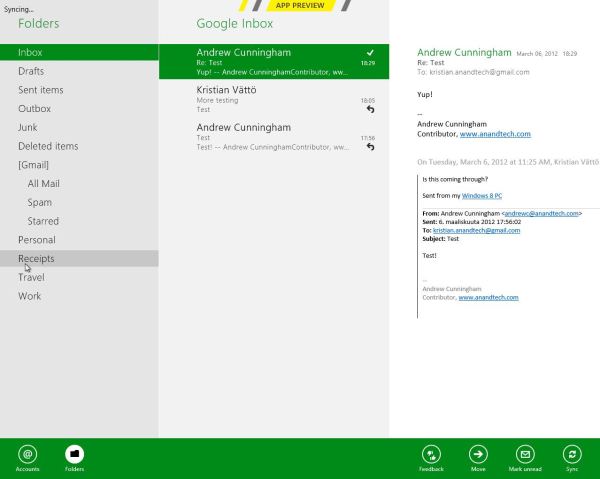
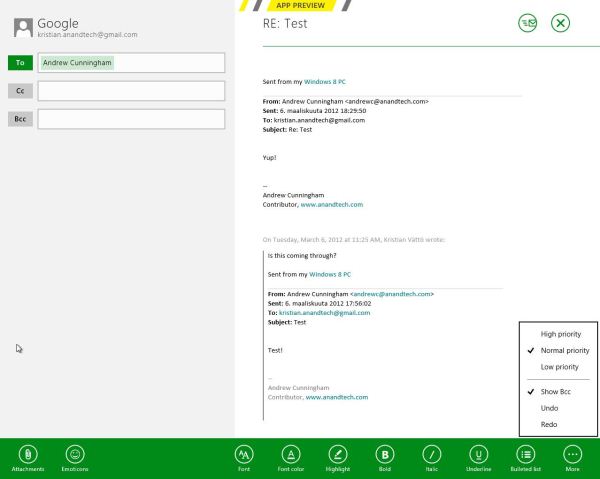
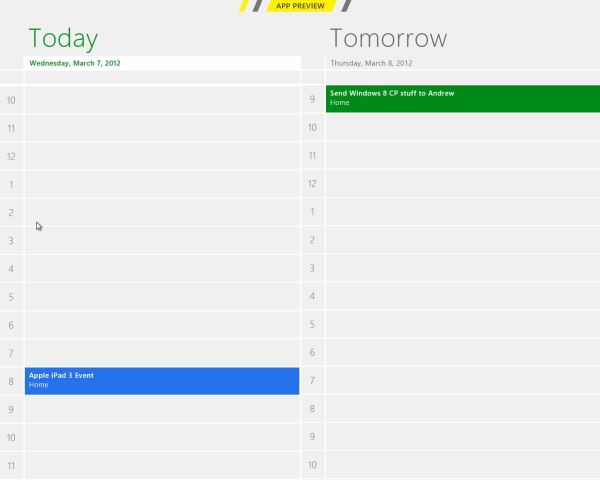
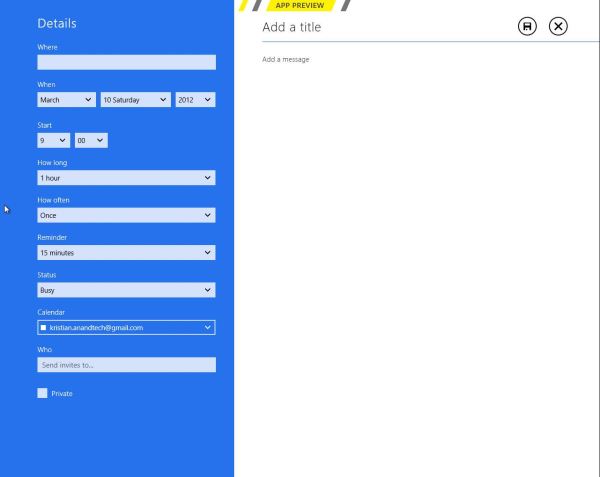
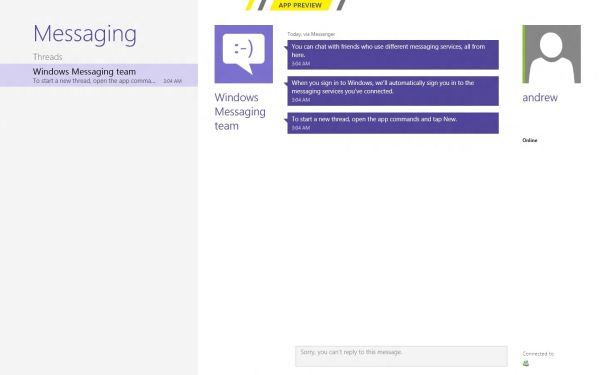
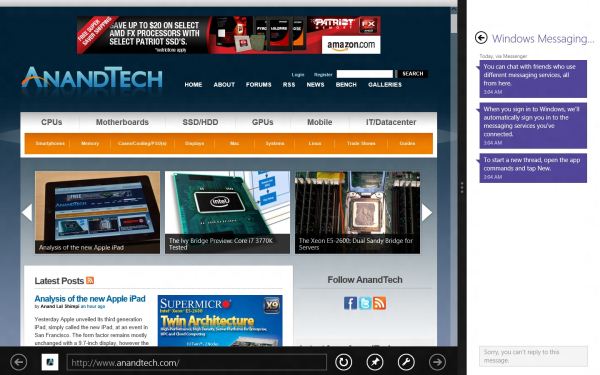
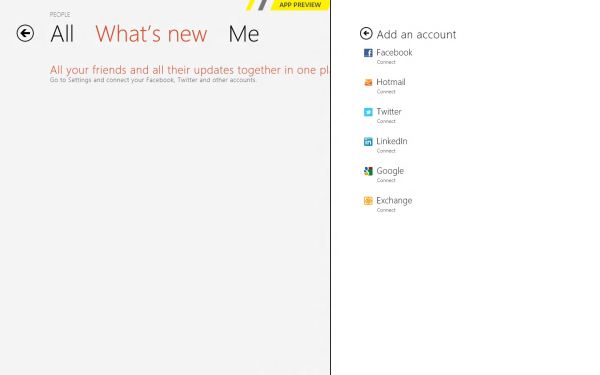
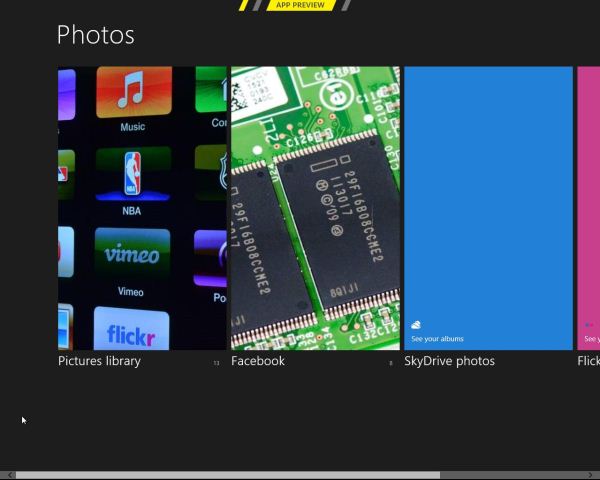










286 Comments
View All Comments
Andrew.a.cunningham - Saturday, March 10, 2012 - link
I've seen that from a couple of other people... Not sure how I missed it. It's on a list of small updates I need to make to the article that I hope I can get to tomorrow.Cardio - Saturday, March 10, 2012 - link
I am running Win 8 CP on a new build Asus Z68, SB @4.7, a Mushkin Chronos SSD and a GTX 580.First I think this is an exceptionally well done review. It is an OS review not hardware. There is no reason to think that the OS will work differently on an AMD or an Intel anymore than win 7 did. I am pretty sure that MS knows there are AMD systems out there and is not going to release an OS that will not run properly on them, seems like that would be the best business plan. I, for one, see nothing wrong with Windows 8. It is faster than 7 and has been completely stable for me and compatible with everything I have tried with the sole exception of CPUZ and ASUS's multiple driver install program that sees it as an unknown OS. The drivers still install normally if done separately.
It is different. Most of the complaints I hear are based just on that. Personally, I wouldn't want it if it wasn't different. If you don't want it don't buy it. If you don't want to do things in a different way you sure don't have to... Windows 7 is and will still be around. All this predictable ranting is the same as happened when DOS went away and every other OS change since. I have used Win 8 enough that the changes in use are now normal and you don't have to think about it. I'm sure before RTM and there after there will be more changes. Thanks for the very nice review. I can imagine what a job it was.
taltamir - Saturday, March 10, 2012 - link
"Metro is here, and if you use Windows 8 you’ll have to come to terms with it."Then I wont be using windows 8.
eezip - Saturday, March 10, 2012 - link
Am I the only one that has trouble with this? I can sign in at https://login.live.com/ and have no problems at all, so I figured that was the login info to use.I installed the Dev Preview when it was released and used a local account. But after recalling the Win8 blog post about Win Live ID syncing, I figured I'd try it before moving to the CP. So I went into the settings and selected "Switch to a Microsoft Account". Seems logical. But I was unable to log in again to the Dev Preview install. Arrrrgh!
So, I clean installed the CP and tried using the Windows Live ID login info from the beginning. I got to the desktop, but the first time I restarted the computer, I couldn't log in. I had entered my phone number and hint info, but I never saw how to enter it. And the CP certainly didn't offer to help me when I was clearly struggling. Since I didn't have a local account, I reinstalled the CP using a local account, which brings me to today.
Is my login at https://login.live.com/ the same login that I *should* be able to use for Win8? I can only assume that I'm doing something wrong, but I sure don't know what it might be.
InsaneScientist - Saturday, March 10, 2012 - link
How long is your password?Try just the first 16 characters if it's longer than that.
For whatever (REALLY STUPID) reason, it'll let you enter a password longer than that, but it only uses the first 16 as the actual password.
(See my comment two below yours, and poke around on google. It's a known issue)
If it's not longer than 16 characters... I have no idea.
b_wallach - Saturday, March 10, 2012 - link
Well what is a in depth when there is nothing very in depth at all. With all the systems tested here it's really a drag that you can't dig up a AMD system and the one everyone wants to see is the BD line.Most people have seen enough to say if you wanted to do a run with the new OS it would be with this cpu because of all the guesses and some beta tests that showed a marked improvement with these cpu's.
Running a bunch of lame Intel systems really makes it kind of a joke. If you did not have a good selection of different brands then why not delay it until you have enough systems to call it a in depth review instead of a who cares review. I'm sure most would say the intel's would do good and so nothing worth noting was done that would add to a lot of how much better will a radical cpu design work on it as everything points to this being a top of the list things people want to know about the new OS.
With some win8 beta tests showing a 5-10% increase I'm sure everyone that has the new BD's has been waiting to see this one over any of the no real supprise Intel lines.
As always it leaves a fairly large question mark about just what can expect from a site that has been less than honest about AMD for many years.
It's only lately I've even come back here after what went on with bad reviews and very few when AMD first put out their first FX line that was better but trying to avoid the Intel inside ads all over and great praise for Intels horrible egg cooker cpu made me stop comming here for many years. I can't understand why anyone would not put AMD's new cpus right up front with Window's 8 so we can get a good amount of data over this hugely argued point all over the web.
So no this was anything but a in depth review. It was a candy coated and/or we need to run a filler story to help the hit counter stay busy right???
Before that Pentium 4 fiasco I came here a lot.
After that I started looking at a lot of other sites where the useful data WAS useful. Intel knew what sites to throw a lot of money or inflence as they hit the top sites of the day, Tom's hardware was also doing the same line of crap and like this site I took a few years leave until they could earn back what little trust in them.
I'm sure some other sites will get the AMD BD / Win 8 test done. I can't wait to see if all the flack about AMD and windows had merrit. If not I'll stick with Win 7.
Sorry about being so glib, this IS a good site now, I just hate it when they don't pay much mind about what has been the top interest about windows 8 because AMD has a lot riding on how well their new cpu's will do with it. If it follows the beta tests it would move the AMD right up into the level of being a competitor as they are very close with current Intel cpus in some areas, even pass intel in quite a few other tests and if they see a 5 to 10% it would def. make AMD's cpu a contender. Not a top of the line one but it would put it where AMD wanted to see it run.
Now that would alone make it a in depth review..
It would even be a huge news item to run if AMD can do as well as the WIn8 beta reviews people might not bash it so much. AMD built this design for what could be a very sound call because a huge portion of computer users may or may not know is software is putting more demands, a lot of people run programs that can work very well in the multi-threaded apps as I have seen quite a few new ones use it and it will probably get more demanding use running 2-5 or more progs at the same time. AMD's new cpu does this part very very well.
Oh well, it seems like me most wanted AMD scores because it is very important towards AMD's future if they can pull the scores that the beta revew saw.
It can be compared to buying a upgraded cpu because new cpu's usually give this kind of increase from old cpu's scores and their new cpu's can do.
Still, it's got a lot of potential once people start coding prog's to work well with new cpu designs. Intel hsa had to face this when a lot of their products acted even worse than the current AMD performance numbers.
Even if I'm totally wrong about a details it's funny to read bad stuff about these cpu's. They do have some issues but for the most part they are still a very fast cpu and will run all software pretty darn fast.
Andrew.a.cunningham - Saturday, March 10, 2012 - link
This was a feature review/preview, not so much a performance review/preview. We'll be measuring performance more thoroughly when we have the RTM build in a few months.InsaneScientist - Saturday, March 10, 2012 - link
Maybe because it's an indepth article on the OS itself and not so much a re-review of every piece of hardware released in the last 5 years to see how it'll run Win 8? Sound reasonable?And no, how bulldozer improves (or doesn't) ISN'T what everyone wants... what everyone wants is to know if they'll be able to use the new interface. Talk to anyone who has any experience with Win8 - Metro WILL come up (fast), bulldozer? - not so much.
Oh, and as a side note, I can't speak for the initial release of the A64 vs P4 days, but I started coming here around the time the A64X2 and Pentium D came out, and I rather remember Anandtech calling it like it was... the performance was not too dissimilar, with the A64X2 having an advantage (sometimes a large one - occasionally a disadvantage), but the Pentium D needing and ungodly amount of power and heat to be competitive with it. They've always done a good job of calling it like it is! I've never understood where the claim that they're Intel biased comes from.
Don't get me wrong, I also want to know if it's going to help (and I really hope it does), but it's just not that important. Mostly because CPUs - both Intel's and AMD's - are generally fast enough.
To quote you: "[Bullzoder CPUs] do have some issues but for the most part they are still a very fast cpu and will run all software pretty darn fast."
Yes! That's it exactly! They're fast enough that it's no longer critical to be looking at hardware performance with a new operating system. Instead, when we look at a new operating system, we want to see... well... that operating system.
Furthermore, this isn't a final release. Software development develops features and then the feature set is locked and the codebase is optimized. So performance WILL change between now and RTM (and it would not be fair to AMD to test it now). Features, on the other hand are pretty close to final, so talking about those is fair game.
On the issues that everyone is talking about (Metro, UI, and feature changes), Andrew et al. did an excellent job, and I applaud them for that.
InsaneScientist - Saturday, March 10, 2012 - link
Have they done anything in the CP about that blasted 16 character limit on (live account linked) passwords?This is (in my opinion) by FAR the most egregious step backwards on Windows 8. Why on earth is there a limit on this? It's 2012 for crying out loud!
And the need for an "All" option (which should be the default) in search from the start screen. I'm seriously considering skipping Win8 just because of this.
I don't mind Metro much, it's not my favorite, but I can work with it... but why oh why did the search functionality have to take a step backwards after they got me hooked on it in Win7. :(
I may be able to use it with the keyboard search shortcuts you mentioned, but that's not exactly a ringing endorsement.
MamiyaOtaru - Saturday, March 10, 2012 - link
" In 2009, Windows 7 brought WDDM 1.1, which focused on reducing system memory usage by removing redundant data, and support for heterogeneous GPU configurations, a change that precluded modern iGPU + dGPU technologies such as NVIDIA’s Optimus."I don't think "preclude" means what you think it means